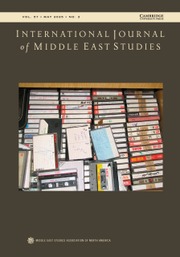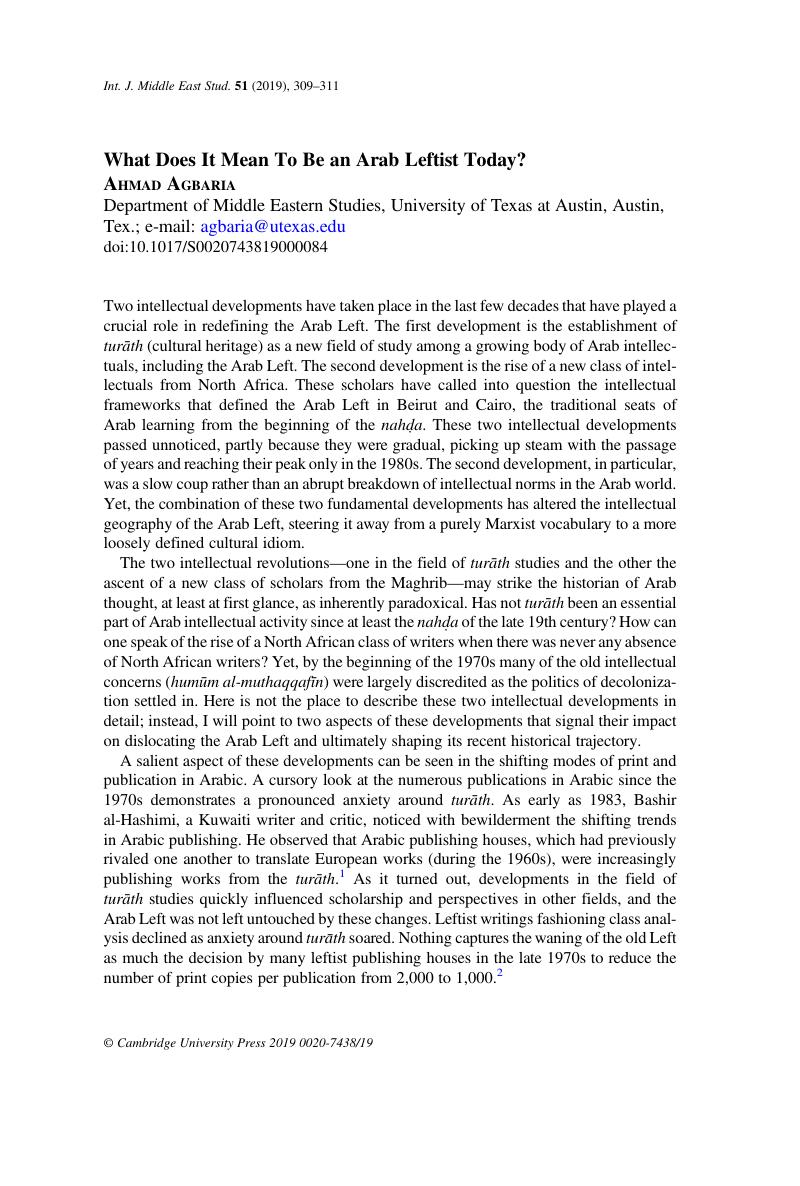Two intellectual developments have taken place in the last few decades that have played a crucial role in redefining the Arab Left. The first development is the establishment of turāth (cultural heritage) as a new field of study among a growing body of Arab intellectuals, including the Arab Left. The second development is the rise of a new class of intellectuals from North Africa. These scholars have called into question the intellectual frameworks that defined the Arab Left in Beirut and Cairo, the traditional seats of Arab learning from the beginning of the nahḍa. These two intellectual developments passed unnoticed, partly because they were gradual, picking up steam with the passage of years and reaching their peak only in the 1980s. The second development, in particular, was a slow coup rather than an abrupt breakdown of intellectual norms in the Arab world. Yet, the combination of these two fundamental developments has altered the intellectual geography of the Arab Left, steering it away from a purely Marxist vocabulary to a more loosely defined cultural idiom.
The two intellectual revolutions—one in the field of turāth studies and the other the ascent of a new class of scholars from the Maghrib—may strike the historian of Arab thought, at least at first glance, as inherently paradoxical. Has not turāth been an essential part of Arab intellectual activity since at least the nahḍa of the late 19th century? How can one speak of the rise of a North African class of writers when there was never any absence of North African writers? Yet, by the beginning of the 1970s many of the old intellectual concerns (humūm al-muthaqqafīn) were largely discredited as the politics of decolonization settled in. Here is not the place to describe these two intellectual developments in detail; instead, I will point to two aspects of these developments that signal their impact on dislocating the Arab Left and ultimately shaping its recent historical trajectory.
A salient aspect of these developments can be seen in the shifting modes of print and publication in Arabic. A cursory look at the numerous publications in Arabic since the 1970s demonstrates a pronounced anxiety around turāth. As early as 1983, Bashir al-Hashimi, a Kuwaiti writer and critic, noticed with bewilderment the shifting trends in Arabic publishing. He observed that Arabic publishing houses, which had previously rivaled one another to translate European works (during the 1960s), were increasingly publishing works from the turāth.Footnote 1 As it turned out, developments in the field of turāth studies quickly influenced scholarship and perspectives in other fields, and the Arab Left was not left untouched by these changes. Leftist writings fashioning class analysis declined as anxiety around turāth soared. Nothing captures the waning of the old Left as much the decision by many leftist publishing houses in the late 1970s to reduce the number of print copies per publication from 2,000 to 1,000.Footnote 2
Another aspect of the development of turāth-related angst was the rise of a “new breed of intellectuals” from North Africa. The decline of class analysis in the Arab world sent writers on the Left scrambling for a new intellectual position as earlier frameworks that had held them together grew obsolete. It is important to recall that the nahḍa of the late 19th century divided the Arabic-speaking world into Mashriq (the beating heart) and Maghrib (periphery). While one should not downplay Maghribi scholars’ contribution to the making of the nahda, the scope and scale of their writings were dwarfed by the Mashriq's remarkable output. This inherently slanted, unequal playing field of intellectual production came to an end at the beginning of the 1970s. Abundant historical evidence now attests to the outsized intervention of North African scholars in defining the post-1970s Arab intellectual landscape. Take, for example, the reputable Beirut publishing house Dar al-Adab, which long represented the Arab Left. During its early years, Dar al-Adab solicited Arab writers to send their writings for publication, but it was mainly Syrian writers who provided the manuscripts they published. Speaking to journalists in 2012, Rana Idriss, the last owner of this publishing house, stated that over the last few decades Moroccan scholars had submitted more manuscripts to her publishing house (126) than scholars of any other Arab country.Footnote 3 Put simply, trends in contemporary Arab thought are pivoting towards turāth studies as the intellectual hubs of Arab intellectual life have transitioned westward. Against this backdrop, one can discern the features that define the new sensibilities and principles of the Arab Left.
The establishment of turāth at the center of Arab thought in recent decades caught the Arab Left off guard. The Arab Left of the 1960s proceeded on the basis that only doing away with the past would set the course for renewal and cultural change. Scholars such as Sadiq Jalal ʿAzm and Yasin al-Hafiz, whose works shaped the principles of the radical generation of the naksa (Arab defeat), thought of the past as a burden that slowed down Arab societies’ march toward modernity, social justice and equality, sovereignty and freedom.Footnote 4 The arrival of turāth, propped up by Maghribi scholars, constituted an epistemological break with the predominant intellectual norms in the Mashriq. One Arab Leftist, Jurj Ṭarabishi, spoke for many when he succinctly captured the “illiteracy” of his generation of their turāth:
I belong to a revolutionary generation that was preceded by two generations of the nahḍa, where we lived in a complete break with al-turāth. Our mental structure [dhihniya] and thought were all directed toward modern Western ideologies, which [we] turned into sacred books whether [these works were] Marxist, nationalist, Socialist, or Unionist. We lived an absolute break [qaṭīʿa kāmila] with al-turāth and viewed it [with disdain] as no more than yellow [cheap and unworthy] books.Footnote 5
Finding themselves in opposition to the intellectual mainstream, the Arab Left pursued the task of repudiating and rebuking the themes, ideas, and topics that preoccupied the majority of Arab authors. The most important case in recent decades was the heated debate between Syrian Jurj Tarabishi and Moroccan Muhammad ʿAbid al-Jabiri. Seeing himself as a scion of the nahḍa, Tarabishi believed, like the pioneers of the early nahda, that it is enough for intellectuals to expose people to new sets of ideas to spur social and cultural change in Arab society. Jabiri did not accept this assumption, widespread among Arab writers in the Mashriq, arguing instead that Arab hadātha (modernity) should emerge from within (min al-dākhil) turāth, not outside it. For Jabiri, turāth, if read and examined from a nonideological position, could provide a new trajectory for Arab modernity from within Arab cultural soil, whereas any modernity external to the domain of turāth was doomed to fail: “there is no path to renewal and hadātha except from within turāth, its mechanisms and possibilities.”Footnote 6
These developments force us to conclude that in the last few decades the Arab Left has been adapting to the new intellectual landscape that emerged in the wake of the two fundamental developments mentioned earlier. During the 1970s, the Arab Left struggled to buck the trend of the renewed debate on authenticity (aṣāla) that swept up Arab thought by doubling down on Marxist writings. Later, and especially from the start of the 1990s, the Arab Left had to adjust its strategy. One way to contend with the shifting debate was to dive into studying turāth, not to affirm its hold over the public imagination but to deconstruct and undercut its epistemological authority over modern Arab peoples. Yet, the new positioning and adaptation of the Arab Left has less to do with its overall weakening or fusion with Islamists, as many historians and anthropologists tend to think. Instead, the Arab Left has been reshuffling its intellectual priorities and struggling to formulate its intellectual principles after it broke away from its Marxist ideological framework.
The debate around turāth alters Arab society and politics in ways that have yet to be explored. The rise of a new class of postcolonial scholars from the margins is sharpening rivalries for intellectual authority with old Marxists. We are a long way from the 1960s when all the purveyors of ideas came from the Mashriq, and when Mashriqi writers such as Zaki al-Arsuzi, Michael ʿAflaq, Satiʿ al-Husari, Taha Husayn, and Salama Musa dominated the intellectual landscape without question. The recent Arab Left is best defined negatively, clustered as it is around opposition to the turāth discourse that has gripped the Arab world. Being anti-turāth while preserving the flame of the nahda in an increasingly battered society constitute the true sensibilities that define the Arab Left today. With a new appreciation for the emerging intellectual landscape centered around the turāth question in the Arab world, it becomes possible to articulate the Arab Left's aspirations and principles.


